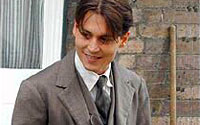
Finding Neverland
by Emily Inlow, MLIS Day
I went to see Finding Neverland with more than a little trepidation. The idea of watching the life story of J.M. Barrie, rumored to have been a pedophile, was not what I wanted to see after a long week of school and work. Adding to my aversion was the fact that his most famous contribution to the literary canon became the namesake of a psychological syndrome that applies to a few too many of my ex-significant others. But I overcame my initial revulsion and went to the movie - and boy, was I glad I did. Though Barrie's fascination with children and his socially incapacitating refusal to accept "adulthood" was a part of the story, this movie was essentially about the creation of Peter Pan, the play, not the syndrome, as well as the process of creation itself.
The movie begins with J.M. Barrie, played by Johnny Depp, waiting in the wings of a theater as his latest play, The Admiral Crichton, is about to premiere. Already we are seeing the world of pretend that he lives in. After Crichton's abysmal failure, Barrie must get back to work on a new play to make up for the financial catastrophe the flop caused for its backers. At this point, Peter Pan is barely an idea. The world Barrie lives in seems infertile ground for its elaborately fanciful beauty. We next see Barrie eating dinner with his wife. The director uses light and sound brilliantly here, setting the two quiet figures against dark walls, a large and impersonal dining room table, and the horrible sounds of forks scraping dinner plates. So begins the story of Barrie's loveless marriage and what eventually will lead to the manifestation of Barrie's internal life called Neverland. Juxtaposed with the dark and sterile elegance of his home is the first scene where we meet the Davies, a family we soon learn are to play a vital role in Barrie's creative process. The setting is a park, filled with golden sunlight and open fields, and Barrie is playing with his gargantuan dog, who in his imagination he likes to pretend is a dancing bear.
There are many juxtapositions like this one in this movie: between his dark and forbidding home and the warm, messy, and laughter-filled Davies home, between his plain gray suits and the colorful costumes of the imaginary characters that Barrie invents as the movie progresses, and between the world of reality, where loved ones get sick and die, and the world of pretend, where children are children forever in a land peopled with pirates, mermaids, and guardian fairies. Richard Hugo in his classic book on creative writing states that every writer must have an internal town he goes to, a triggering town. To be able to write about this town, the writer must know the streets, the people, the trees, the stray dogs - every detail. Barrie's triggering town was Neverland and throughout this movie he visits it often. Finding Neverland shows how writers' lives shape their internal visions and how, through a process as magical as the original work, they share these visions with the rest of the world.
Barrie was not a man who refused to grow up. Even in Neverland, Time, in the form of a ticking crocodile, is always present. He saw and felt the tragedies that life always brings, and chose a way of dealing with them that in the movie transforms not only his own life, but all the lives he touches. One of the final scenes of the movie happens as the play Peter Pan premieres. It is a striking contrast to the movie's first scene, where his play was booed by the audience. In this scene, the joy of children clapping their hands to save Tinkerbell's life, transforms both the audience in the play's theater and the audience in the movie theater, bringing back memories of childhood for both. For any of you who clapped your hands as hard as you could in order to save Tinkerbell's life, you will be thrilled to see Neverland as perhaps Barrie did, full of color and magical creatures. Or perhaps you will just want to shut your eyes and leave Neverland to the world of the imagination.
